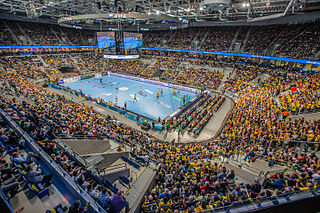
Handball is a team sport in which two teams of seven players each pass a ball using their hands with the aim of throwing it into the goal of the opposing team. A standard match consists of two periods of 30 minutes, and the team that scores more goals wins.

Lacrosse is a team sport played with a lacrosse stick and a lacrosse ball. It is the oldest organized sport in North America, with its origins with the indigenous people of North America as early as the 12th century. The game was extensively modified by European colonists, reducing the violence, to create its current collegiate and professional form.

Futsal is a football-based game played on a hard court like a basketball court, smaller than a football pitch, and mainly indoors. It has similarities to five-a-side football and indoor football.

In sport, a goal may refer to either an instance of scoring, or to the physical structure or area where an attacking team must send the ball or puck in order to score points. The structure of a goal varies from sport to sport, and one is placed at or near each end of the playing field for each team to defend. For many sports, each goal structure usually consists of two vertical posts, called goal posts, supporting a horizontal crossbar. A goal line marked on the playing surface between the goal posts demarcates the goal area. Thus, the objective is to send the ball or puck between the goal posts, under or over the crossbar, and across the goal line. Other sports may have other types of structures or areas where the ball or puck must pass through, such as the basketball hoop. Sports which feature goal scoring are also commonly known as invasion games.
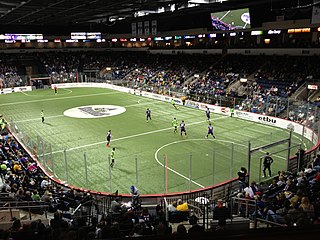
Indoor soccer or arena soccer is five-a-side or six-a-side version of minifootball, derived from association football and adapted to be played in walled hardcourt indoor arena. Indoor soccer, as it is most often known in the United States and Canada, was originally developed in these two countries as a way to play soccer during the winter months, when snow would make outdoor play difficult. In those countries, gymnasiums are adapted for indoor soccer play. In other countries the game is played in either indoor or outdoor arenas surrounded by walls, and is referred to by different names.

The Major Indoor Soccer League (MISL) was the top professional indoor soccer league in the United States. The league was a member of both the United States Soccer Federation and FIFA. The MISL had replaced the NPSL which folded in 2001. According to MISL.net, the league ceased operations as of May 31, 2008. "We are considering structural changes that will bring us greater efficiencies, while also allowing long term growth and expansion of the League", said John Hantz, former Chairman of the MISL, and Owner/Operator of the Detroit Ignition. All the teams from MISL went to the new indoor leagues: NISL, MASL and the XSL. The NISL and XSL used the same playing rules as the MISL.

Gaelic games are a set of sports played worldwide, though they are particularly popular in Ireland, where they originated. They include Gaelic football, hurling, Gaelic handball and rounders. Football and hurling, the most popular of the sports, are both organised by the Gaelic Athletic Association (GAA). Women's versions of hurling and football are also played: camogie, organised by the Camogie Association of Ireland, and ladies' Gaelic football, organised by the Ladies' Gaelic Football Association. While women's versions are not organised by the GAA, they are closely associated with it but are still separate organisations.

Indoor hockey is an indoor variant of field hockey. It is similar to the outdoor game in that two teams compete to move a hard ball into the goal of the opposing side using hockey sticks. Indoor hockey is played on a smaller area and between smaller teams than field hockey and the sidelines are replaced by solid barriers from which the ball rebounds and remains in play.

Fistball is a sport of European origin, primarily played in the German-speaking nations of Austria, Germany and Switzerland, as well as in Brazil. The objective of the game is similar to volleyball, in that teams try to hit a ball over a net, but the rules vary from volleyball in a number of major ways. The current men's fistball World Champions are Germany, winners of both the 2019 Men's World Championships and the fistball category at the 2022 World Games, while the current women's fistball World Champions are also Germany, after winning the 2021 Women's World Championships.

Valencian pilota is a traditional handball sport played in the Valencian Community. Its origins are not known.
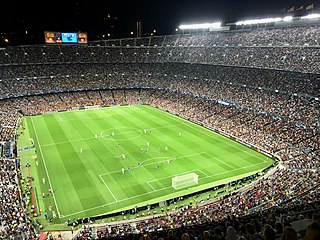
Sport in Europe tends to be highly organized with many sports having professional leagues. The origins of many of the world's most popular sports today lie in the codification of many traditional games, especially in Great Britain. However, a paradoxical feature of European sport is the remarkable extent to which local, regional and national variations continue to exist, and even in some instances to predominate.

Yoon Kyung-shin is a South Korean handball manager and former player.

The 2015 World Men's Handball Championship was the 24th staging of the World Men's Handball Championship, organised by the International Handball Federation (IHF). The final tournament was held for the first time in Qatar, from 15 January to 1 February 2015. The Qatari bid was selected over those of Norway, Poland and France after a vote by the IHF Council on 27 January 2011, in Malmö, Sweden. This was the third time that the World Championship was hosted in the Middle East And North Africa, after Egypt in 1999 and Tunisia in 2005.

The handball tournaments at the 2016 Summer Olympics in Rio de Janeiro was held from 6 to 21 August at the Future Arena in the Barra Olympic Park. The tournaments were won by Denmark in the men's competition and Russia for the women's tournament. The French teams for both competitions finished with the silver medal, and the bronze went to Germany and Norway, respectively.
The IHF Men's Handball World Championship has been organized indoor by the International Handball Federation since 1938.
The IHF Women's Handball World Championship has been organized by the International Handball Federation since 1957. European teams have won every time except 1995 where South Korea won as the first team outside Europe and 2013 where Brazil won as the first American team. The biggest winners are Russia and Norway with four titles each.
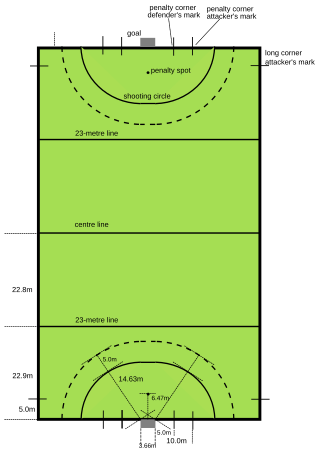
A hockey pitch is the playing surface for the game of field hockey. Historically, the game was played on natural turf (grass) and nowadays it is predominantly played on an artificial turf. The transition onto artificial pitches came during the 1970s and was made mandatory for major competitions in 1976. All the lines, markings and goal specifications are outlined by the International Hockey Federation in "The Rules of Hockey".
This article contains lists of achievements in major senior-level international indoor handball, beach handball and field handball tournaments according to first-place, second-place and third-place results obtained by teams representing different nations. The objective is not to create combined medal tables; the focus is on listing the best positions achieved by teams in major international tournaments, ranking the nations according to the most podiums accomplished by teams of these nations.
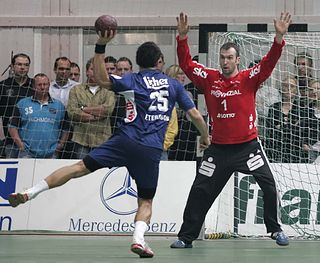
The handball goalkeeper is the most defensive player of their team. Their main task is to prevent the other team from scoring a goal.
This article contains lists of achievements in major senior-level international Olympic team ball sports tournaments according to first-place, second-place and third-place results obtained by teams representing different nations. The objective is not to create combined medal tables; the focus is listing the best positions achieved by teams in major international tournaments, ranking every nation according to most number of podiums accomplished by each nations team.
















